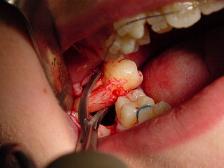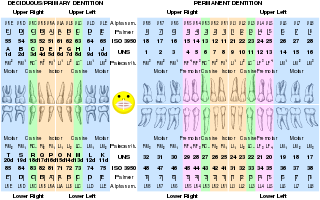
Horse teeth refers to the dentition of equine species, including horses and donkeys. Equines are both heterodontous and diphyodontous, which means that they have teeth in more than one shape, and have two successive sets of teeth, the deciduous and permanent sets.

Human teeth function to mechanically break down items of food by cutting and crushing them in preparation for swallowing and digesting. As such, they are considered part of the human digestive system. Humans have four types of teeth: incisors, canines, premolars, and molars, which each have a specific function. The incisors cut the food, the canines tear the food and the molars and premolars crush the food. The roots of teeth are embedded in the maxilla or the mandible and are covered by gums. Teeth are made of multiple tissues of varying density and hardness.

Dentition pertains to the development of teeth and their arrangement in the mouth. In particular, it is the characteristic arrangement, kind, and number of teeth in a given species at a given age. That is, the number, type, and morpho-physiology of the teeth of an animal.

The molars or molar teeth are large, flat teeth at the back of the mouth. They are more developed in mammals. They are used primarily to grind food during chewing. The name molar derives from Latin, molaris dens, meaning "millstone tooth", from mola, millstone and dens, tooth. Molars show a great deal of diversity in size and shape across the mammal groups. The third molar of humans is sometimes vestigial.

Dorudon ("spear-tooth") is a genus of extinct basilosaurid ancient whales that lived alongside Basilosaurus 40.4 to 33.9 million years ago in the Eocene. It was a small whale, with D. atrox measuring 5 metres (16 ft) long and weighing 1–2.2 metric tons. Dorudon lived in warm seas around the world and fed on small fish and mollusks. Fossils have been found along the former shorelines of the Tethys Sea in present-day Egypt and Pakistan, as well as in the United States, New Zealand and Western Sahara.

A dental extraction is the removal of teeth from the dental alveolus (socket) in the alveolar bone. Extractions are performed for a wide variety of reasons, but most commonly to remove teeth which have become unrestorable through tooth decay, periodontal disease, or dental trauma, especially when they are associated with toothache. Sometimes impacted wisdom teeth cause recurrent infections of the gum (pericoronitis), and may be removed when other conservative treatments have failed. In orthodontics, if the teeth are crowded, healthy teeth may be extracted to create space so the rest of the teeth can be straightened.

Wolf teeth are small, peg-like horse teeth, which sit just in front of the first cheek teeth of horses and other equids. They are vestigial first premolars, and the first cheek tooth is referred to as the second premolar even when wolf teeth are not present. Torbjörn Lundström in Sweden reported that about 45-50% of 25000 horses had wolf teeth. They are much less common in the mandible than the maxilla although mandibular wolf teeth are found very occasionally.

Dental professionals, in writing or speech, use several different dental notation systems for associating information with a specific tooth. The three most common systems are the FDI World Dental Federation notation, the Universal Numbering System, and the Palmer notation. The FDI notation is used worldwide, and the Universal is used widely in the United States. The FDI notation can be easily adapted to computerized charting.
Mammalodon is an extinct genus of archaic baleen whale belonging to the family Mammalodontidae.
Dental anatomy is a field of anatomy dedicated to the study of human tooth structures. The development, appearance, and classification of teeth fall within its purview. Tooth formation begins before birth, and the teeth's eventual morphology is dictated during this time. Dental anatomy is also a taxonomical science: it is concerned with the naming of teeth and the structures of which they are made, this information serving a practical purpose in dental treatment.
Occlusion, in a dental context, means simply the contact between teeth. More technically, it is the relationship between the maxillary (upper) and mandibular (lower) teeth when they approach each other, as occurs during chewing or at rest.
This is a list of definitions of commonly used terms of location and direction in dentistry. This set of terms provides orientation within the oral cavity, much as anatomical terms of location provide orientation throughout the body.

An equine malocclusion is a misalignment between the upper and lower jaws of a horse or other equine. It results in a faulty bite with the upper and lower teeth failing to meet correctly. Malocclusions can cause pain to the horse and may also lead to weight loss and other eating problems related to poor chewing or loss of appetite. In addition, discomfort can lead to poor behavior when the animal is ridden or driven, particularly if a bit is used in the horse's mouth.

A tooth is a hard, calcified structure found in the jaws of many vertebrates and used to break down food. Some animals, particularly carnivores and omnivores, also use teeth to help with capturing or wounding prey, tearing food, for defensive purposes, to intimidate other animals often including their own, or to carry prey or their young. The roots of teeth are covered by gums. Teeth are not made of bone, but rather of multiple tissues of varying density and hardness that originate from the outermost embryonic germ layer, the ectoderm.
Many different terms have been proposed for features of the tooth crown in mammals.

Hipposideros besaoka is an extinct bat from Madagascar in the genus Hipposideros. It is known from numerous jaws and teeth, which were collected in a cave at Anjohibe in 1996 and described as a new species in 2007. The site where H. besaoka was found is at most 10,000 years old; other parts of the cave have yielded H. commersoni, a living species of Hipposideros from Madagascar, and some material that is distinct from both species. H. besaoka was larger than H. commersoni, making it the largest insectivorous bat of Madagascar, and had broader molars and a more robust lower jaw. As usual in Hipposideros, the second upper premolar is small and displaced from the toothrow, and the second lower premolar is large.

Teeth are common to most vertebrates, but mammalian teeth are distinctive in having a variety of shapes and functions. This feature first arose among early therapsids during the Permian, and has continued to the present day. All therapsid groups with the exception of the mammals are now extinct, but each of these groups possessed different tooth patterns, which aids with the classification of fossils.
The infundibulum of a tooth is the funnel-like center that is filled with cementum. The funnel is widest at the top (crown) which is the grinding (occlusal) surface. The infundibulum is also known as the dental cup. Simple tooth infundibula occur most notably in the incisors of horses and other equids, but they also occur in the premolars and molars of ruminants and camelids. The infundibula found in ruminants can get quite complex some with two funneling centers, and with multiple folding in the sides of the cup. These folds produce greater amounts of enamel in vertical curtains that substantially increase the durability of the tooth. The cheek teeth of elephants express this in a slightly different form with the vertical curtains of enamel coming in from the sides and meeting in the middle.

Cheek teeth or postcanines comprise the molar and premolar teeth in mammals. Cheek teeth are multicuspidate. Mammals have multicuspidate molars and premolars situated between canines and molars whose shape and number varies considerably among particular groups. For example, many modern Carnivora possess carnassials, or secodont teeth. This scissor-like pairing of the last upper premolar and first lower molar is adapted for shearing meat. In contrast, the cheek teeth of deer and cattle are selenodont. Viewed from the side, these teeth have a series of triangular cusps or ridges, enabling the ruminants' sideways jaw motions to break down tough vegetable matter. Cheek teeth are sometimes separated from the incisors by a gap called a diastema.
Wareolestes rex is a mammaliaform from the Middle Jurassic (Bathonian) rocks of England and Scotland. It was originally known from isolated teeth from England, before a more complete jaw with teeth was found in the Kilmaluag Formation of Skye, Scotland.












